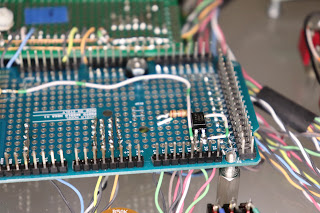Keeping with the original building intention, the optocoupler circuit was moved to the controller's prototyping board. There was ample room and clearance between the the board and controller board was not an issue. The devices could have gone on the other side of the board if there was a size issue, but it was hard to reach through all the wires.
An LED across the headphone electrodes lit up at every expected note, so the signal was good. With this in mind, the MIDI signal was run directly to the Arduino pins. This lacked electrical protection.
Arduino's SerialPassthrough sketch was modified to display incoming MIDI data. The lines were divided by recognizing that 255 (B11111111) often appeared, so that was assumed to be the start or end of a new note. Notes were being sent from the old version of this project since it regularly sent out random notes, even if they were not easy to control.
As soon as the Arduino reconnected with the prototyping board, all manner of nonsense came through the serial port and not even at the same rate as before. The data signal looked compromised by proximity to other connections. A pull-up resistor was installed to try to counteract this noise.
The resistor did nothing to calm the garbage data, so the Arduino was removed. Jumpers were reconnected and the incoming signal looked clean again. It seemed like the Arduino had an issue with being plugged onto the protoyping board.
Resistance at the suspicious points was measured and a short was found at the incoming and receiving pin for serial1. This explained the garbage data, which was the outgoing signal getting looped back into the receiving port.
The rest of the posts for this project have been arranged by date.
First time here?
Completed projects from year 1
Completed projects from year 2
Completed projects from year 3
Completed projects from year 4
Completed projects from year 5
Completed projects from year 6
Disclaimer for http://24hourengineer.blogspot.com and 24HourEngineer.com
This disclaimer must be intact and whole. This disclaimer must be included if a project is distributed.
All information in this blog, or linked by this blog, is not to be taken as advice or solicitation. Anyone attempting to replicate, in whole or in part, is responsible for the outcome and procedure. Any loss of functionality, money, property or similar, is the responsibility of those involved in the replication.
All digital communication regarding the email address 24hourengineer@gmail.com becomes the intellectual property of Brian McEvoy. Any information contained within these messages may be distributed or retained at the discretion of Brian McEvoy. Any email sent to this address, or any email account owned by Brian McEvoy, cannot be used to claim property or assets.
Comments to the blog may be utilized or erased at the discretion of the owner. No one posting may claim property or assets based on their post.
This blog, including pictures and text, is copyright to Brian McEvoy.
2019-04-14
Optocoupler on the controller board
An LED across the headphone electrodes lit up at every expected note, so the signal was good. With this in mind, the MIDI signal was run directly to the Arduino pins. This lacked electrical protection.
MIDI signal piped directly to Arduino pins
Arduino's SerialPassthrough sketch was modified to display incoming MIDI data. The lines were divided by recognizing that 255 (B11111111) often appeared, so that was assumed to be the start or end of a new note. Notes were being sent from the old version of this project since it regularly sent out random notes, even if they were not easy to control.
Serial data as seen by the controller
As soon as the Arduino reconnected with the prototyping board, all manner of nonsense came through the serial port and not even at the same rate as before. The data signal looked compromised by proximity to other connections. A pull-up resistor was installed to try to counteract this noise.
Pull-up resistor installed
The resistor did nothing to calm the garbage data, so the Arduino was removed. Jumpers were reconnected and the incoming signal looked clean again. It seemed like the Arduino had an issue with being plugged onto the protoyping board.
Receiving a signal through jumpers
Resistance at the suspicious points was measured and a short was found at the incoming and receiving pin for serial1. This explained the garbage data, which was the outgoing signal getting looped back into the receiving port.
Short discovered
The rest of the posts for this project have been arranged by date.
First time here?
Completed projects from year 1
Completed projects from year 2
Completed projects from year 3
Completed projects from year 4
Completed projects from year 5
Completed projects from year 6
Disclaimer for http://24hourengineer.blogspot.com and 24HourEngineer.com
This disclaimer must be intact and whole. This disclaimer must be included if a project is distributed.
All information in this blog, or linked by this blog, is not to be taken as advice or solicitation. Anyone attempting to replicate, in whole or in part, is responsible for the outcome and procedure. Any loss of functionality, money, property or similar, is the responsibility of those involved in the replication.
All digital communication regarding the email address 24hourengineer@gmail.com becomes the intellectual property of Brian McEvoy. Any information contained within these messages may be distributed or retained at the discretion of Brian McEvoy. Any email sent to this address, or any email account owned by Brian McEvoy, cannot be used to claim property or assets.
Comments to the blog may be utilized or erased at the discretion of the owner. No one posting may claim property or assets based on their post.
This blog, including pictures and text, is copyright to Brian McEvoy.
2019-04-14






Comments
Post a Comment